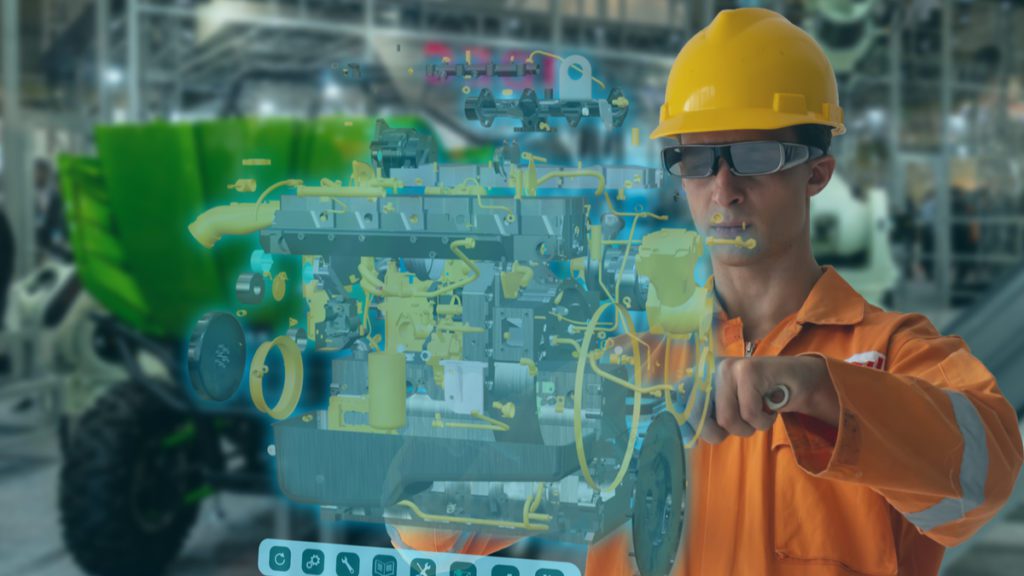With all the excitement in the news about the Metaverse recently, it would be easy to dismiss the whole idea as nothing more than marketing hype without any real substance. But, dig a little deeper into the technologies required to power the Metaverse, and you might be surprised at how many practical uses exist and are available right now, as well as a host of innovations just over the horizon. Digital twin technology is one such area that was just getting a foothold in the last year or two. Recent interest in the Metaverse, accompanied by funding for Metaverse projects, may be just the boost that digital twins need to see mainstream acceptance and recognition.
We have already seen the major cloud providers staking their claims. Microsoft has launched Azure Digital Twins, with ontologies (pre-existing model sets) for real estate, construction, and energy grids. Google announced its Supply Chain Twin, with ready-to-deploy connectors and transformational pipelines. Amazon’s approach is to make it easier to create digital twins of real-world systems such as buildings, factories, industrial equipment, and production lines using their cloud-based AWS IoT TwinMaker.
With these players pouring resources into the technology, along with their ability to reach major partners willing to adopt their platforms and take real-world products to market quickly, it becomes apparent that digital twin technology is here now and will only get stronger over the coming months and years.
What Are Digital Twins?
So, what are digital twins, and what makes them such an important part of the Metaverse? To put it simply, a digital twin is a digital model of a real-world entity. But when I say model, I don’t mean something as simple as a visual three-dimensional representation. It can be an object, a system, or a process. It must be able to function exactly or as close as possible to the real entity.
In many cases, the digital twin is connected to its real-world counterpart, with real-time data synchronization that ensures that the digital model maintains all the necessary characteristics. It doesn’t stop at being a representation of the entity at some point in time in the past; it can use data feeds, often generated by IoT object connections, to stay current.
Of course, it isn’t necessary that the digital twins are constantly synchronized. It depends on the use case. For instance, if you want to perform what-if analysis on the digital model, you might choose to decouple the two, so that you can introduce changes only to your digital twin.
There is still no agreed-upon standard for exactly what the Metaverse is. However, we tend to agree that it consists of virtual worlds and experiences. In some cases, those worlds may not correlate to anything in the real world. They could be limited only by our imagination. But there are also many ways that the Metaverse may be much more connected to its real-world counterparts.
You might, for instance, wish to visit a venue where something is happening in real-time, like a concert or a sports event. The digital experience should be as close as possible to the real event and would require information to be shared in both directions.
The information would travel from sensors at the venue, to keep the Metaverse experience up-to-date. Interactions by the attendee in the Metaverse would be transmitted back to the site. These concepts are still visions of the future, but the technology required to achieve that experience is being put into production today.
What Are Some Ways Digital Twins Are Being Used Today?
Take the sports arena scenario, for instance. A company called Venue Twin provides a system where stadiums, arenas, shopping malls, airports, and theme parks can be built in digital form and experienced with strikingly realistic, interactive digital twins. These digital twins can be built to simulate properties that you already have in order to plan events and operations with hyper-realistic fly-throughs.
They can also be built to test out a facility before it even exists. For example, the LA Clippers use Venue Twin to plan the Intuit Dome, the “technologically advanced and basketball-obsessed arena and entertainment venue that will deliver a uniquely intimate and intense experience when it opens for the 2024-2025 season.”
Another way that digital twin technology is being used today is for training purposes. When we can create an extremely realistic digital simulation of a real-world entity, we open many possibilities for teaching and learning. Students at the Darmstadt University of Applied Sciences use digital twins from Siemens to learn about automation and control technology. They can “run an assembly plant that reproduces the automation processes in a real factory.”
These experiences would never be possible to replicate in a university lab without great cost and space, not to mention safety concerns. This same technology could be used by manufacturing companies to train maintenance workers to diagnose and correct issues on the manufacturing line, without ever having to stop the manufacturing process.
What Does the Future Hold for Digital Twins?
While much of the media coverage of the Metaverse seems to involve leaving behind the real world and entering a fully digital one, one of the most exciting ways that digital twins are showing promise is in helping us improve our physical world. Nvidia CEO, Jensen Huang, announced a new supercomputer called E2 (Earth 2), which will be a digital twin of Earth itself. The company’s plan is to simulate and predict climate change, with the goal of finding ways to mitigate its effects.
In addition to environmental issues, medical advancement is another area we could see benefits from the use of digital twins. Siemens has made progress in the use of digital twins to establish better medical device performance, with support from the FDA and other regulatory agencies. Medical researchers in France are developing a digital twin model to assess different approaches to the repair of bone fractures. Additionally, Swedish researchers are developing a digital twin by mapping mice RNA to help predict the effect of different types and doses of arthritis drugs.
Conclusion
It’s easy to be skeptical of new technology if your only viewpoint is 30-second Super Bowl commercials or news headlines. You may have to brush aside the very superficial, intentionally sensational media coverage, and look for real-life adoption. Scientific studies, white papers, and announcements of real products with actual users paint a picture of emerging technology that is anything but hype, with interesting applications now and an exciting future ahead.
Want to compete in the Metaverse? Subscribe to the My Metaverse Minute Channel:










